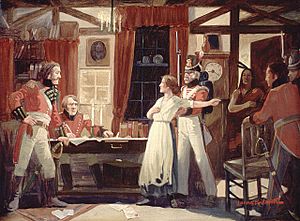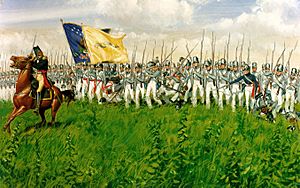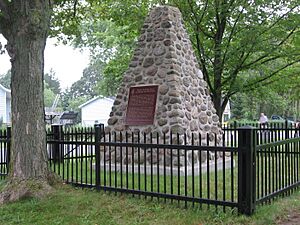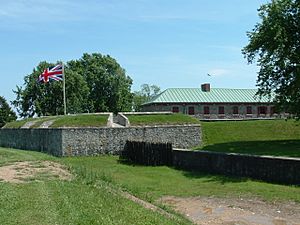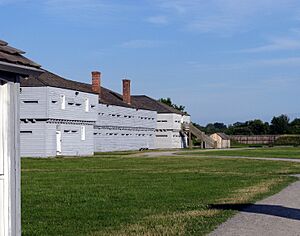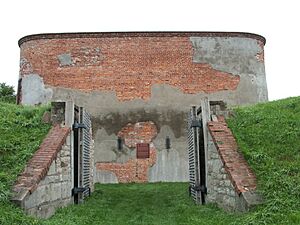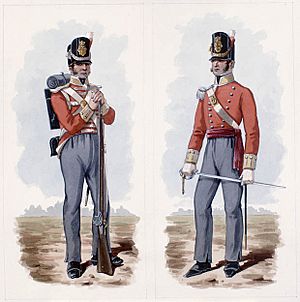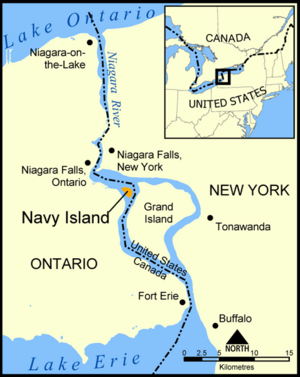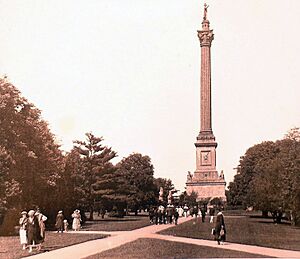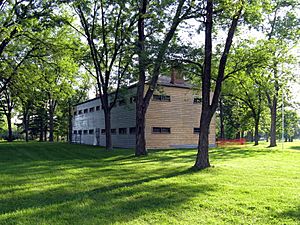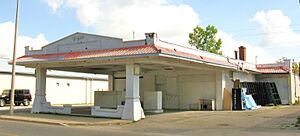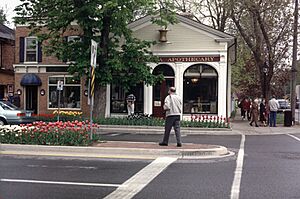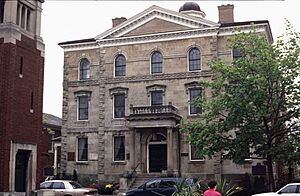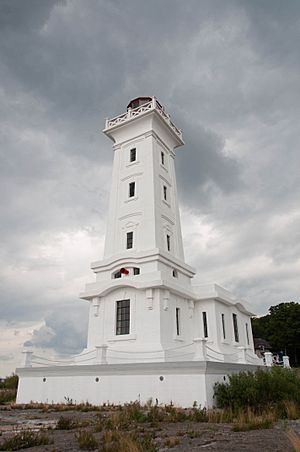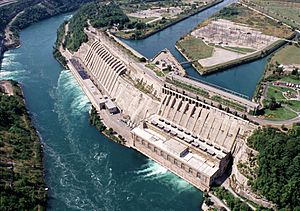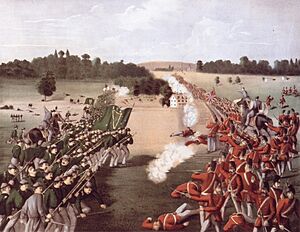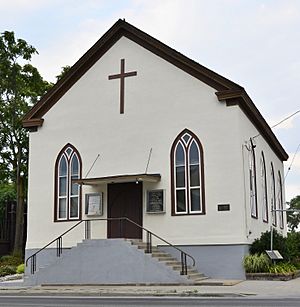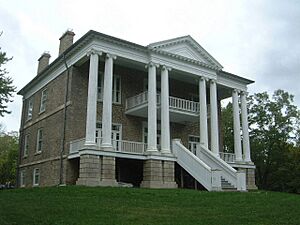List of National Historic Sites of Canada in Niagara Region facts for kids
This article lists the National Historic Sites in the Niagara Region, Ontario. These are special places in Canada that have been officially recognized for their important history. There are 26 such sites in Niagara. Nine of them are looked after by Parks Canada, which is Canada's national park service. You'll see a small beaver icon ![]() next to these sites in the list.
next to these sites in the list.
The Niagara Region also has many important historical events and people remembered with special plaques. These plaques look similar to the ones for historic sites. This list uses the official names given by the Historic Sites and Monuments Board.
If you want to learn about other National Historic Sites in Ontario, you can find them at National Historic Sites in Ontario.
Contents
- Explore Niagara's Historic Sites
- Sites from the War of 1812
- Other Important Historic Sites
- Butler's Barracks
- Former L.J. Shickluna Service Station
- Niagara Apothecary
- Niagara District Court House
- Niagara-on-the-Lake (Historic District)
- Point Abino Light Tower
- Queenston-Chippawa Hydro-electric Plant
- R. Nathaniel Dett British Methodist Episcopal Church
- Ridgeway Battlefield
- Salem Chapel, British Methodist Episcopal Church
- Toronto Power Generating Station
- Willowbank
- See also
Explore Niagara's Historic Sites
Here's a list of the National Historic Sites in the Niagara Region. Each one tells a unique story about Canada's past.
Sites from the War of 1812
Many sites in Niagara are connected to the War of 1812, a conflict between the United States and Great Britain (which included Canada at the time).
Battle of Beaver Dams
- Date: 1813
- Location: Thorold
- What happened: This was the site of a big British victory during the War of 1812. A brave woman named Laura Secord walked a long way to warn the British about an American attack, which helped them win the battle.
- Image:
Battle of Chippawa
- Date: 1814
- Location: Chippawa
- What happened: This battle was part of the last major American invasion of Canada during the War of 1812.
- Image:
Battle of Cook's Mills
- Date: 1814
- Location: Cooks Mills
- What happened: This was the very last fight between American and British/Canadian armies in the Niagara area during the War of 1812. It was one of the final battles fought on Canadian soil.
- Managed by: Parks Canada

- Image:
Battle of Lundy's Lane
- Date: 1814
- Location: Niagara Falls
- What happened: This was a very bloody battle during the War of 1812. British and American forces met by chance, and the fight lasted for six hours. It stopped the American advance into Upper Canada.
- Image:
Battlefield of Fort George
- Date: 1813
- Location: Niagara-on-the-Lake
- What happened: This was one of the fiercest battles of the War of 1812. The U.S. forces managed to get a foothold in the Niagara area here. It's different from the nearby Fort George site.
- Managed by: Parks Canada

Fort Drummond
- Date: 1814
- Location: Niagara-on-the-Lake
- What happened: This was a small fort and cannon battery built during the War of 1812. It protected an important road from Chippawa to Queenston. Some of its original walls are still there.
Fort Erie
- Date: 1808 (third fort completed)
- Location: Fort Erie (town)
- What happened: This was the first British fort built in this area after the Seven Years' War. It was captured and destroyed by American forces in 1814 during the War of 1812. The fort was rebuilt in the 1930s.
- Image:
Fort George
- Date: 1799 (completed), 1940 (reconstruction completed)
- Location: Niagara-on-the-Lake
- What happened: This is a rebuilt British fort that was the main defense in the Niagara Peninsula during the War of 1812. It's a separate site from the Battlefield of Fort George.
- Managed by: Parks Canada

- Image:
Fort Mississauga
- Date: 1814 (completed)
- Location: Niagara-on-the-Lake
- What happened: This fort is in a key spot at the mouth of the Niagara River. It was built to protect the Canadian border and to face Fort Niagara on the U.S. side. It's the only fort of its kind (a square tower inside a star-shaped earthwork) left in Canada.
- Managed by: Parks Canada

- Image:
Frenchman's Creek
- Date: 1812
- Location: Fort Erie
- What happened: This was a small fight in the War of 1812. British forces pushed American soldiers back across the Niagara River. This failure helped stop a larger American invasion planned for Niagara.
- Image:
Mississauga Point Lighthouse
- Date: 1804 (completed), 1814 (demolished)
- Location: Niagara-on-the-Lake
- What happened: This was the very first lighthouse on the Great Lakes. It was built by soldiers in 1804. It was damaged in the Battle of Fort George and taken down when Fort Mississauga was built on the same spot.
- Managed by: Parks Canada

- Image:
- Date: 1761 (shipyard established)
- Location: Niagara Falls
- What happened: This uninhabited island on the Canadian side of the Niagara River has important archaeological remains. In the 1760s, it was home to the first British shipyard for the Upper Great Lakes. Later, during the Upper Canada Rebellion, it was where William Lyon Mackenzie set up his own government, the Republic of Canada.
- Managed by: Parks Canada

- Image:
Queenston Heights
- Date: 1812
- Location: Niagara-on-the-Lake
- What happened: This is a hill on the Niagara Escarpment where the British stopped an American invasion in the Battle of Queenston Heights during the War of 1812. It's also home to Brock's Monument and a monument to Laura Secord.
- Managed by: Parks Canada

- Image:
Vrooman's Battery
- Date: 1812
- Location: Niagara-on-the-Lake
- What happened: This was a cannon battery that fired at American forces crossing the Niagara River during the Battle of Queenston Heights. Today, it's just a mound on the riverbank.
Other Important Historic Sites
Butler's Barracks
- Date: 1814–1854 (completed)
- Location: Niagara-on-the-Lake
- What happened: This is a group of five wooden buildings built by the British after the War of 1812. They were used as a military camp for 150 years, showing a long history of military presence.
- Managed by: Parks Canada

- Image:
Former L.J. Shickluna Service Station
- Date: Around 1924
- Location: Port Colborne
- What happened: This old service station is built in a unique Spanish Colonial Revival style. It's a symbol of how quickly cars and car culture grew after World War I.
- Image:
Niagara Apothecary
- Date: 1820
- Location: Niagara-on-the-Lake
- What happened: This white, single-story building was a pharmacy from about 1866 to 1964. It's one of the very few old pharmacy shops still left.
- Image:
Niagara District Court House
- Date: 1847
- Location: Niagara-on-the-Lake
- What happened: Designed by William Thomas, this building is a great example of a mid-19th-century public building. It originally held the local court, jail, market, and town hall.
- Image:
Niagara-on-the-Lake (Historic District)
- Date: 1815–1859
- Location: Niagara-on-the-Lake
- What happened: This historic area is an early-19th-century town founded by Loyalists. It has 25 city blocks with the best collection of buildings in Canada from the time after the War of 1812.
- Image:
Point Abino Light Tower
- Date: 1918
- Location: Crystal Beach
- What happened: This lighthouse is at the eastern end of Lake Erie. It was designed to match the fancy summer homes nearby, making it more elaborate than most Canadian lighthouses. Many of its original features are still intact.
- Image:
Queenston-Chippawa Hydro-electric Plant
- Date: 1925
- Location: Niagara-on-the-Lake
- What happened: When it was finished, this was the first large-scale hydroelectric power project in the world. It uses the power of water to create electricity.
- Image:
R. Nathaniel Dett British Methodist Episcopal Church
- Date: 1836
- Location: Niagara Falls
- What happened: This church is named after and connected to the early life of composer Robert Nathaniel Dett. It shows the history of early black settlement in Niagara and the church's role in helping refugees from the Underground Railroad.
- Image:
Ridgeway Battlefield
- Date: 1866
- Location: Fort Erie
- What happened: This is where Canadian soldiers defended Canada against Fenian raiders from the United States. The Fenians were Irish-American groups who tried to invade Canada.
- Managed by: Parks Canada

- Image:
Salem Chapel, British Methodist Episcopal Church
- Date: 1855
- Location: St. Catharines
- What happened: This church was an important center for abolitionist activity in Canada during the 19th century. It is strongly linked to Harriet Tubman, a famous conductor on the Underground Railroad.
- Image:
Toronto Power Generating Station
- Date: 1913
- Location: Niagara Falls
- What happened: This was the first generating station at Niagara Falls that was completely owned by Canada. It supplied hydro-electric power to Toronto. Its design is a beautiful and unusual example of Beaux-Arts architecture used for an industrial building.
- Image:
Willowbank
- Date: 1836
- Location: Niagara-on-the-Lake
- What happened: This is a large estate with a grand mansion. Its design and untouched exterior show how Neoclassical architecture and a love for natural, beautiful landscapes came together in large country estates in Upper Canada in the early 1800s.
- Image:
See also
- Niagara Peninsula
- Neutral Nation


